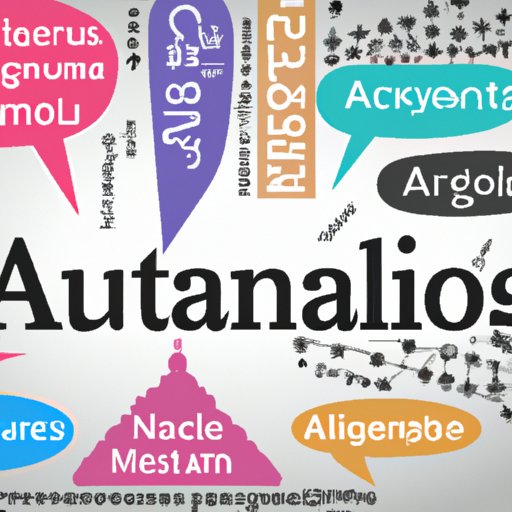Introduction
Artificial Intelligence (AI) is one of the most talked-about topics in technology today. But what exactly is AI? And what can it do for us? In this article, we’ll explore the basics of AI and explain it in plain English. We’ll also discuss its potential benefits and risks, and its impact on society.

Explaining Artificial Intelligence in Plain English
Let’s start by defining Artificial Intelligence. AI is defined as “the theory and development of computer systems able to perform tasks normally requiring human intelligence, such as visual perception, speech recognition, decision-making, and translation between languages.” In other words, AI is the ability of a machine or computer program to think and learn. It can simulate the way a human brain works and make decisions based on data it has been given.
To illustrate what AI can do, here are some examples of AI in action:
- Virtual assistants like Siri, Alexa, and Google Assistant that can answer questions and give you recommendations.
- Facial recognition software used for security purposes.
- Chatbots that can understand and respond to customer inquiries.
- Autonomous vehicles that can drive themselves.
A Beginner’s Guide to Artificial Intelligence
Now that you have a basic understanding of what AI is, let’s take a closer look at the basics of AI. Here’s what you need to know:
What Are the Basics of Artificial Intelligence?
At its core, AI is a combination of algorithms, data, and machines that can learn from their environment and make decisions without human intervention. It relies on three main components:
- Algorithms: Algorithms are sets of instructions that an AI system uses to learn, interpret data, and make decisions.
- Data: AI systems need access to large amounts of data in order to learn and make accurate decisions.
- Machines: Machines are physical devices that use the algorithms and data to carry out tasks.
How Does Artificial Intelligence Work?
AI systems use machine learning to improve over time with experience. This means that the more data they are exposed to, the better they get at making decisions. AI systems use two main types of machine learning: supervised learning and unsupervised learning.
In supervised learning, the AI system is trained with labeled data. This means that the data is labeled with the correct answer so that the AI system can learn from it. For example, if the AI system is trying to identify cats in photos, it would be shown thousands of photos of cats and told which ones are cats and which ones are not.
In unsupervised learning, the AI system is not given any labeled data. Instead, it must figure out how to sort and classify the data on its own. This type of machine learning is often used for clustering, which is the process of organizing data into groups based on similarities.
Artificial Intelligence: What It Can Do for You
Now that you understand how AI works, let’s take a look at some of the things it can do for you. Here are some of the top applications of AI:
Automation
One of the most popular uses of AI is automation. AI systems can automate tasks that would otherwise require manual labor, such as sorting through large amounts of data or responding to customer inquiries. This can drastically reduce costs and increase efficiency in businesses.
Predictive Analytics
AI systems can also be used for predictive analytics. This means that they can analyze data and make predictions about future events. For example, a retail store could use AI to predict customer behavior and optimize its inventory accordingly.
Natural Language Processing
Natural language processing (NLP) is another area where AI is being used. NLP involves teaching computers to understand and process human language. This can be used for text analysis, voice recognition, and automated customer service.
Artificial Intelligence: What Are the Benefits and Risks?
AI has the potential to revolutionize the way we live and work, but there are also risks associated with it. Let’s take a look at the potential benefits and risks of AI:
Benefits
The potential benefits of AI are immense. AI can help us make faster and more accurate decisions, automate tedious tasks, and even save lives. According to a study by McKinsey Global Institute, AI could add $13 trillion to the global economy by 2030.
Risks
On the other hand, AI also poses a number of risks. These include job displacement, privacy concerns, and the potential for biased decision-making. It’s important to consider these risks before implementing AI systems.
Artificial Intelligence: What Is Its Impact on Society?
The potential impacts of AI on society are both positive and negative. Here are some of the most common effects of AI on society:
Positive Impacts
AI has the potential to improve healthcare, education, and transportation, as well as create new jobs and industries. AI can also help us tackle climate change and make our cities smarter and more efficient.
Negative Impacts
On the other hand, AI also has the potential to increase inequality and disrupt the labor market. It can lead to job displacement and create ethical dilemmas around the use of AI in decision-making. There are also concerns about the misuse of AI for malicious purposes.
Conclusion
In conclusion, Artificial Intelligence is a rapidly growing field with tremendous potential. While AI offers many benefits, it also poses some risks that must be addressed. It’s important to understand the implications of AI and take steps to ensure that it is used responsibly. With careful consideration and the right safeguards in place, AI can be a powerful tool for improving our lives.
(Note: Is this article not meeting your expectations? Do you have knowledge or insights to share? Unlock new opportunities and expand your reach by joining our authors team. Click Registration to join us and share your expertise with our readers.)
